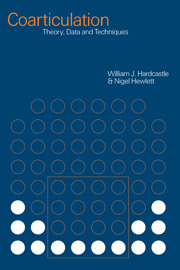Book contents
- Frontmatter
- Contents
- List of figures
- List of tables
- List of contributors
- Acknowledgments
- Introduction
- Part I Theories and models
- 1 The origin of coarticulation
- 2 Coarticulation models in recent speech production theories
- Part II Research results: components of the motor system for speech
- Part III Wider perspectives
- Part IV Instrumental techniques
- References
- Index
2 - Coarticulation models in recent speech production theories
Published online by Cambridge University Press: 22 September 2009
- Frontmatter
- Contents
- List of figures
- List of tables
- List of contributors
- Acknowledgments
- Introduction
- Part I Theories and models
- 1 The origin of coarticulation
- 2 Coarticulation models in recent speech production theories
- Part II Research results: components of the motor system for speech
- Part III Wider perspectives
- Part IV Instrumental techniques
- References
- Index
Summary
Introduction
A crucial problem of speech production theories is the dichotomy between the representational and the physical aspects of speech. The former is described as a system of abstract, invariant, discrete units (the phonemes), the latter as a complex of variable, continuous, overlapping patterns of articulatory movements resulting in a variable acoustic signal, a mixture of continuous and discrete events (Fant 1968). There is general agreement in the literature that the variability and unsegmentability of the speech signal is due in great part to the universal phenomenon of coarticulation, i.e. the pervasive, systematic, reciprocal influences among contiguous and often non-contiguous speech segments. This explains why coarticulation has a central place in all recent phonetic theories.
The aim of coarticulation theories is to explain coarticulation, i.e. account for its origin, nature and function, while coarticulation models are expected to predict the details of the process bridging the invariant and discrete units of representation to articulation and acoustics. Coarticulation theories are also expected to explain how listeners overcome coarticulatory variability and recover the underlying message.
As for production, the differences among the various theories of coarticulation may concern the nature of the underlying units of speech, the stage at which coarticulatory variations emerge within the speech production process, what is modified by coarticulation and why.
- Type
- Chapter
- Information
- CoarticulationTheory, Data and Techniques, pp. 31 - 66Publisher: Cambridge University PressPrint publication year: 1999
- 9
- Cited by



